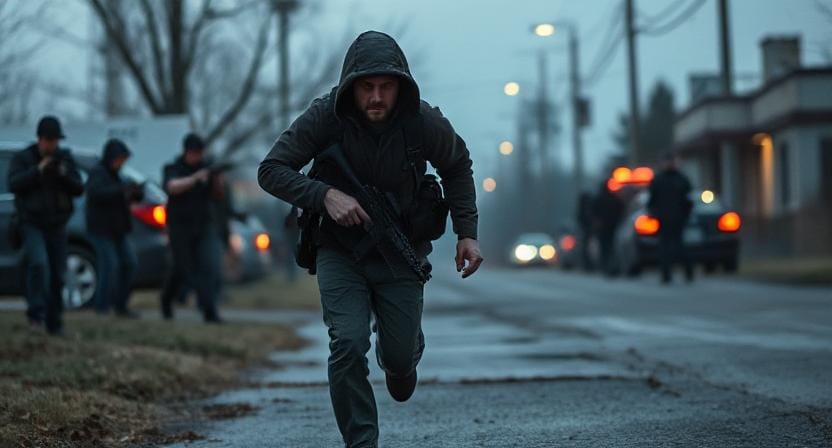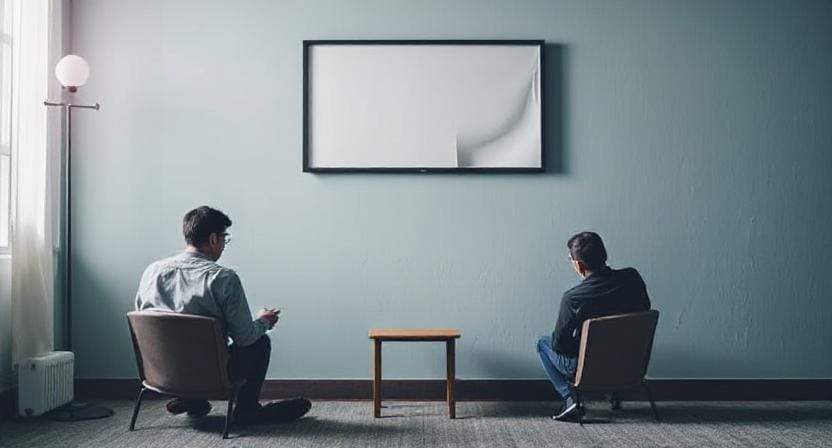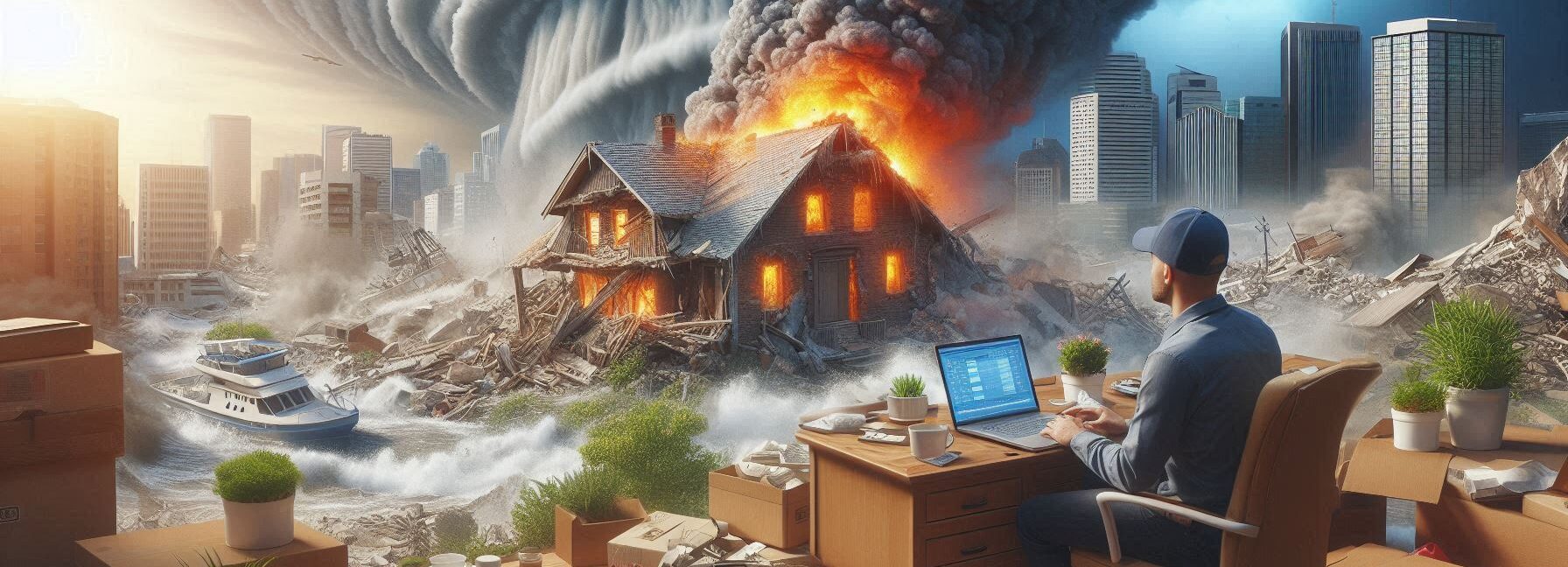Please Note: This post may contain affiliate links. If you click one of them, we may receive a commission at no extra cost to you. As an Amazon Associate, I earn from qualifying purchases.
Last Updated on November 1, 2025 by Kevin Collier

Top Takeaways and Key Concepts
- Run if Safe: Evacuate immediately if a safe path is available; leave belongings behind.
- Hide if Escape Isn't Possible: Find a secure location, lock doors, silence devices, and remain quiet.
- Fight Only as a Last Resort: If confronted, act aggressively using available objects to incapacitate the shooter.
- Call 911 When Safe: Provide clear information: location, shooter description, and number of victims.
- Follow Law Enforcement Instructions: Keep hands visible and comply with commands to avoid being mistaken for a threat.
It's very disturbing to think about what might happen if there was an active shooter. It feels like thinking about your in-laws coming over without warning, which is not fun at all! But hey, getting ready might make you feel a little better, right?
Staying calm is really important if you ever find yourself in a genuinely stressful situation. I know, it's easier said than done. If you can, take a deep breath. Taking a short break can help you think more clearly.
Find exits immediately away. It's like looking for the closest bathroom when you really need one. Your goal is to get out safely. Go for it if you notice a door. If you can't get out, find a place to hide. Find a strong barrier that will keep you safe and out of sight.
You might also want to turn off your phone. It's like turning off that obnoxious ringtone. No one wants to tell anyone where they are hiding. Please be quiet if you can. Paying attention might help you understand what's going on around you.
If you're among other people, cuddle together and be silent. Even when things are hard, it's nice to have friends around.
Call for aid when it's safe. Your voice is strong. Let them know what's going on. There is help on the way!
Keep in mind that going through these procedures is like getting ready for a major game. It’s not fun, but being ready can make a significant difference. So get a cup of coffee, relax, and remember that you can handle hard times when they come. You can do this!
Stay Calm and Assess the Situation

*** Shop for Survival Gear - Tools - Kits ***
Survival Gear - Bags and Backpacks - Knives - Boots/Footwear - Communication
Outdoor Cooking - Gloves - Hydration - Dry Boxes - Water Filtration Systems
Tents - Sleeping Bags - First Aid Kits - Multi-Tools - Flashlights - Fire Starters
Navigation - Survival Food - Night Vision - Headlamps - Stun Guns - Binoculars
First things first: take a breath. Yes, I realize this sounds like something your yoga teacher would say while everyone is trying not to fall over in downward dog. But it's really important to maintain cool when things get crazy around you. Your brain can be your best friend or your worst enemy. Let's hope it's the first.
Take a moment to think about what's going on. Is that sounds gunfire or just someone dropping a bag of potatoes? (And by the way, if it's potatoes, you're probably okay.) Pay close attention and seek for indicators of trouble. It's time to do something if folks are running and shouting like they just seen Bigfoot in the parking lot.
It's interesting that knowing where the exits are before crisis starts can save you a few seconds while you're in a panic. Learn the escape routes as soon as you get to a new place, such a restaurant or mall, so you won't be caught off guard later.
You Have Three Choices: Run, Hide, Or Fight

Let's talk about the three main things you should do if you see an active shooter: run, hide, or fight. These are like tools for staying alive; each one has its own benefits and cons.
Run!
Run if you can see a clear way to safety and it feels right. You don't have to pace yourself here; this isn't a marathon.
Get out of there as soon as you can! As soon as you're out of danger, phone 911 and give them as much information as you can without sounding like you've just sprinted a mile uphill.
But keep in mind that you shouldn't go back for your things. That favorite jacket might look amazing on Instagram, but it's not worth putting your life in danger for.
Get Out Of Sight!
What if you can't run? Then the best thing to do is hide. Find a safe place, like behind something heavy like furniture or in a locked room, and stay quiet! Even while it might seem tempting, this isn't the time to talk to strangers or share snacks.
Turn off the lights and put your phone on silent so it doesn't give away your location with all those annoying messages about kitten videos (which we all adore). If you're among a group, make sure everyone knows that whispering sweet nothings won't help right now!
Battle!
Finally, if you really have to, fight back against the assailant with anything you have on hand. I'm not kidding, people. I'm talking about chairs, fire extinguishers, and more. Even those beautiful artisanal loaves of bread from the bakery department could be useful! Keep in mind that fighting should always be the last option after trying everything else.
Talk to Each Other Well

Communication is really important in any emergency, particularly one as crazy as this one! If you've been able to escape or hide, let the police know right away when it's safe to do so. Give them as much information as you can about what you've seen; every little thing matters!
Texting instead of calling may actually make it more likely that you'll get through, since phone lines often get busy rapidly during emergencies (who knew texting was more than simply delivering memes?). Let your family know you're safe, too. They'll be glad to hear from you in the middle of their own worry!
What Happens After the Incident?
Thank heavens police enforcement is there and in charge of the problem. But that doesn't mean all is done and dusted yet. You still have some actions to take!
If you were personally involved in an active shooter scenario or even just saw one, you may have emotional effects later on, such anxiety or PTSD symptoms.
It's quite normal to require help after going through anything terrible, so don't be afraid to get it from local groups that specialize in trauma rehabilitation.
Hey, do you know what's funny? We are quite worried about terrible stuff like active shooters. But if you think about it, the chances of that happening aren't very high. It's like being afraid of walking on a LEGO piece. That hurts, right? But we've all been there, and it happens a lot more often!
Every day, life throws all sorts of things at us. Traffic, slides, and those pesky shopping carts that go rogue. Those are the small things that can get us into trouble at any time. But we generally deal with them quite fine.
Sometimes it's normal to be scared. I understand. Fear might feel like that awkward silence at a family dinner, which is fairly big and weighty. But keep in mind that we safely get through our days by paying attention to what's in front of us.
It helps to keep things in perspective. Every small thing you do can make a difference. Being aware of what's going on around you and being safe in everyday things, like staying away from those annoying LEGOs. Getting ready can help you feel more sure of yourself.
And don't forget to breathe! Also, take a moment to laugh. Tell your pals some funny stories. They can make anyone feel better. You are not the only one who has good and bad times in life. Be sensible, be careful, and take things one day at a time. You can do it!
Frequently Asked Questions
What is the first recommended action in an active shooter situation?
If a safe escape route exists, immediately evacuate the area without stopping for belongings.
What should I do if I cannot escape?
Find a secure hiding place, lock or obstruct entry points, silence devices, and remain quiet and out of sight.
When is it appropriate to fight the shooter?
Only as an absolute last resort, and only when your life is in immediate danger and no other options remain.
Should I call 911 during the event?
Yes, but only when it is safe to do so, and provide clear details such as location, shooter description, and number of victims if known.
How should I behave when law enforcement arrives?
Keep your hands visible, follow instructions immediately, and avoid sudden movements to prevent being mistaken as a threat.
Why is silencing phones important when hiding?
Unwanted noises or alerts can reveal your location and increase danger for you and others nearby.
Should I attempt to help others escape?
If safe, encourage others to leave with you, but do not delay escape or jeopardize your own safety to retrieve items or persuade someone who refuses.
Suggested Resources:
Active Shooter Preparedness
https://www.ready.gov/active-shooter-preparedness
Responding to Active Shooter Situations
https://www.fbi.gov/how-we-can-help-you/safety-resources/active-shooter-safety-resources
Surviving an Active Shooter Event
https://www.dhs.gov/publication/surviving-active-shooter-event

Kevin Collier is a seasoned survivalist and expert in prepping and homesteading, contributing to WiseSurvive.com. With a deep-rooted passion for self-sufficiency and outdoor survival skills, Kevin shares practical advice, strategies, and resources to help individuals prepare for any challenge. His informative articles cover a range of topics, from essential survival techniques to sustainable living practices, empowering readers to thrive in any situation. Whether you're a novice or a seasoned prepper, Kevin's insights will inspire you to take charge of your readiness and build resilience for the future.




